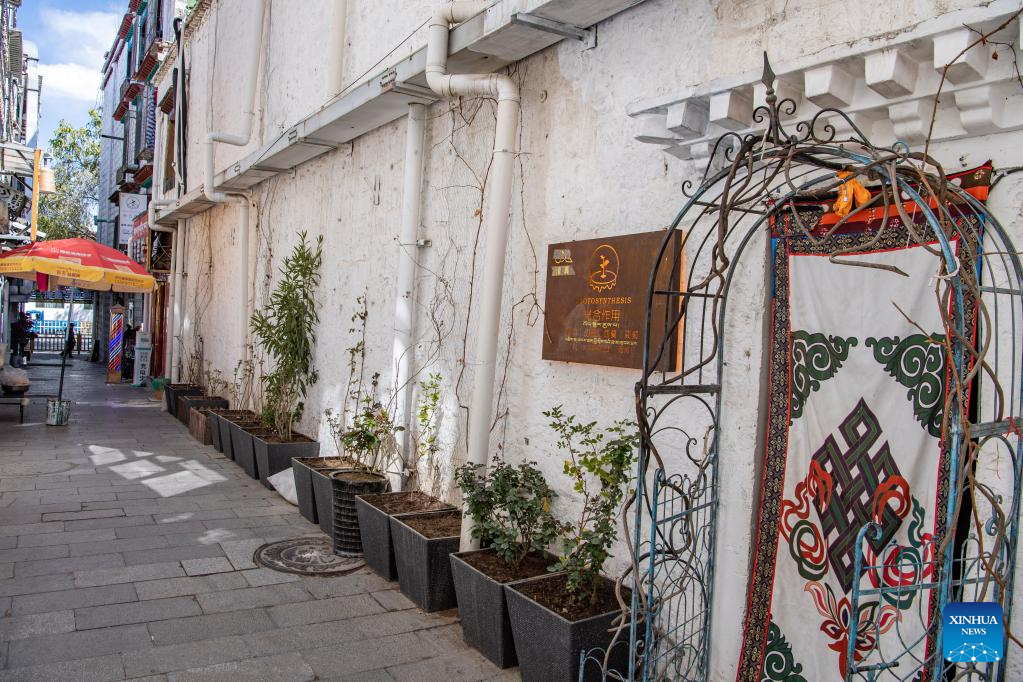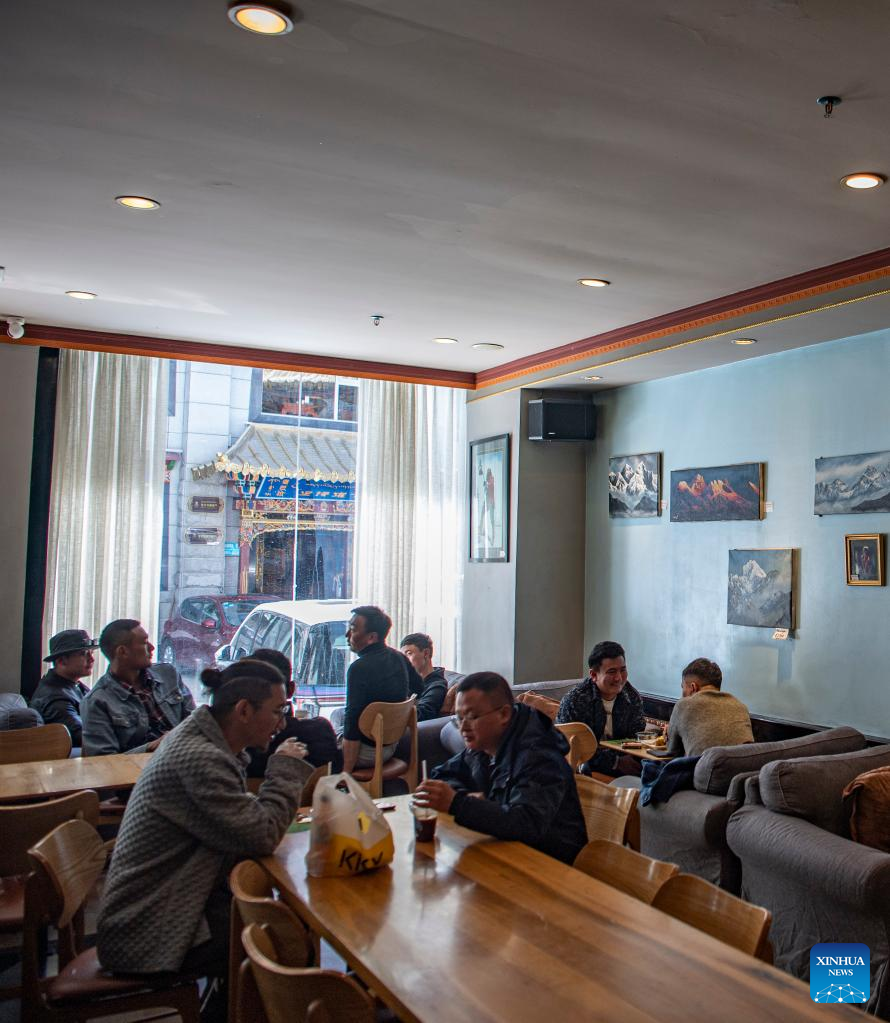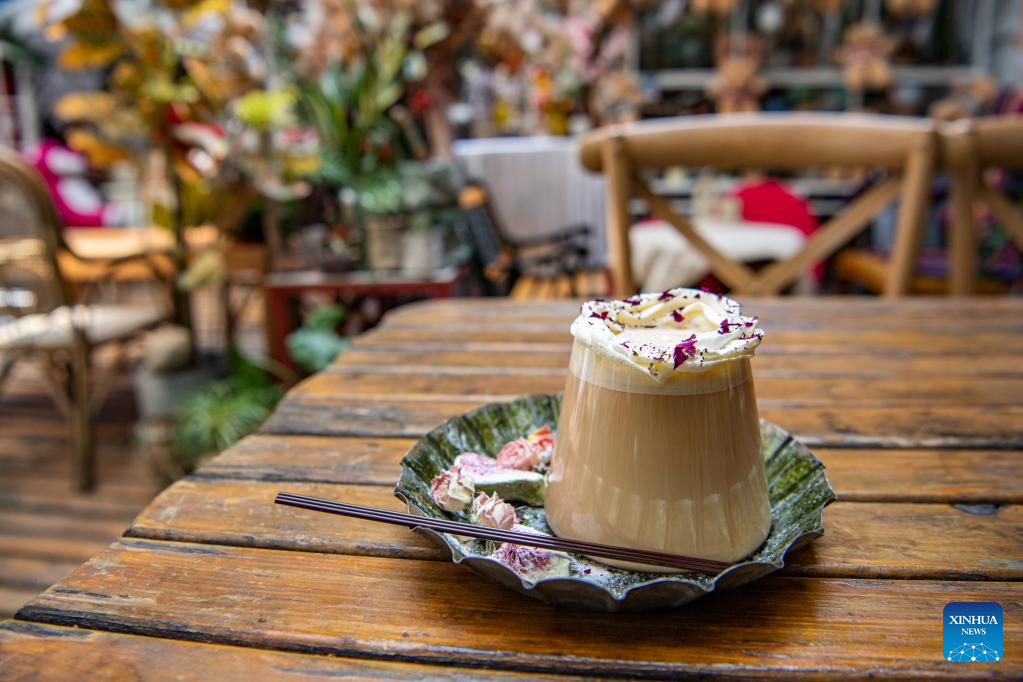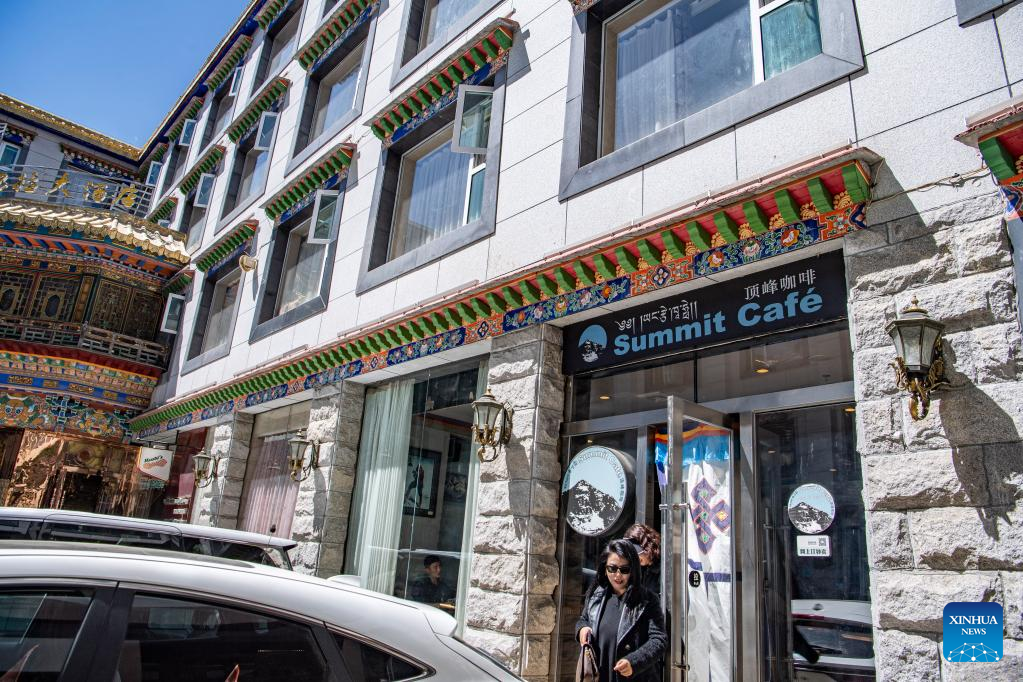


This photo taken on April 6, 2023 shows the Photosynthesis Cafe in Lhasa, southwest China's Tibet Autonomous Region. (Xinhua/Sun Fei)
by Cao Bin
LHASA, April 7 (Xinhua) -- As I drove past the majestic Potala Palace, I glanced to my left and was surprised to see a familiar logo of "%" emblazoned against the backdrop of pristine white. Wait! Could it possibly be the unmistakable signage of a popular cafe brand?
With a growing presence in cities like Kyoto, Berlin and Shanghai, % Arabica opened its first store in Lhasa in March, adding a touch of cosmopolitan chic to the "roof of the world."
Caught by the sight, I went straight to the cafe that afternoon. Out of habit, I ordered a cup of latte. It's the same rich aroma and taste that had fueled so many of my days while working in Hong Kong. Yet, as I sipped my coffee in this new setting, the view of snow-capped mountains and the majestic Potala Palace was a stark contrast to the frenetic hustle and bustle of Hong Kong's city streets.
The traditional Tibetan diet has spawned a profound tea culture, in which herders drink sweet tea or yak butter tea to help digest mutton and beef. What is less known is that aromatic coffees have also become an important part of daily life, especially among the young, just like in other parts of China.
A search for "coffee shop" on Dianping, the Chinese version of Yelp, in Lhasa produces over 1,300 results, almost rivaling the number of "tea shops" with some 1,500 results.
Driven by curiosity, I searched for the history of when the pitch-black drink made its way into the plateau. As per records, the first cafe in Tibet opened in Gyangze, a county about 300 km west of Lhasa, around the 1930s. Coffee was initially referred to as "Cikqia" in the Tibetan language, which translates to "burnt tea." Eventually, the word "Gofee" came to be used as the name for coffee.
In 1959, people in Tibet launched a democratic reform that ended the region's feudal serfdom and freed about 1 million serfs, over 90 percent of the region's total population at the time. Tibet has since entered a period of rapid development.
In 2021, the per capita disposable income of urban residents in Lhasa was 49,299 yuan (about 7,162 U.S. dollars), an increase of 13 percent over the previous year, and 1,887 yuan higher than the national average.
Tibet has proven to be quick to adapt to and integrate into the modern world.
Yungdrung Drolma, who makes a living by painting in Lhasa, has named her WeChat account "coffee bean."
Frequently burning the midnight oil, the hard-working 34-year-old has regarded coffee as a vital and invigorating necessity.
"I fell in love with coffee right away. I started with something sweet, like a cappuccino. Now I only consume Americano, the bitterer the better," she told me.
In a bid to appeal to both the younger Tibetan demographic and tourists alike, it's also become increasingly common to find coffee products infused with traditional Tibetan elements.
I often indulge in a cup of Tibetan cheese mocha. With chewy bits of cheese infused within, the mocha boasts a rich flavor profile and leaves a lingering aroma in the mouth.
Duan Jianan, a talented barista working in a cafe near Barkhor Street, has created a truly unique concoction -- fermented highland barley coffee. This popular beverage combines fermented highland barley grains with iced coffee, becoming an instant hit among customers.
During peak season, the unique coffee, priced at 48 yuan per cup, can sell more than 30 cups a day. "This is the signature product of our cafe," Duan told me.
While at the cafe where Duan works, I had the pleasure of meeting Sonam, a 38-year-old primary school teacher, who was taking a leisurely break with a colleague during their lunch hour. They opted for sparkling Americano coffee and milk tea from the cafe's menu.
Sonam told me she was born in neighboring Shannan City and attended school in Beijing. Her first encounter with coffee was at a Starbucks in Chengdu, the capital of Sichuan Province neighboring Tibet, and she thought "it was so very foreign."
"I think Tibet now has more contact with the outside world. Young people often leave the autonomous region to study, work and travel. It is inevitable for them to integrate into the coffee culture," she said. I couldn't help but agree with her perspective.
While traditional sweet tea and yak butter tea remain ubiquitous in Lhasa, there's something undeniably enticing about the aroma of coffee wafting through the streets.
For me, savoring a cup of coffee is a unique way to experience the city's modernity and innovation.

People enjoy coffee in Summit Cafe in Lhasa, southwest China's Tibet Autonomous Region, April 6, 2023. (Xinhua/Sun Fei)

This photo taken on April 6, 2023 shows a branch of % Arabica cafe store near the Potala Palace in Lhasa, southwest China's Tibet Autonomous Region. (Xinhua/Sun Fei)

A cup of coffee offered by Photosynthesis Cafe is pictured in Lhasa, southwest China's Tibet Autonomous Region, April 6, 2023. (Xinhua/Sun Fei)

This photo taken on April 6, 2023 shows the Summit Cafe in Lhasa, southwest China's Tibet Autonomous Region. (Xinhua/Sun Fei)
点击右上角![]() 微信好友
微信好友
 朋友圈
朋友圈

请使用浏览器分享功能进行分享
